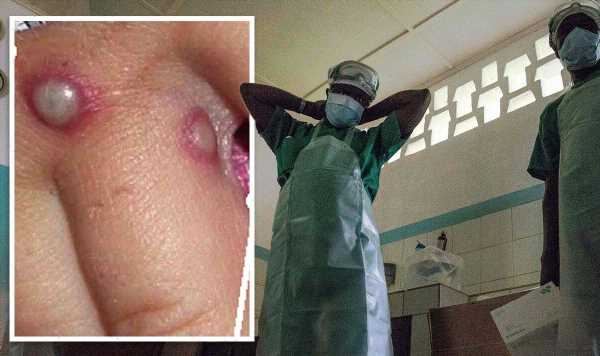Monkeypox: Rare disease explained
We use your sign-up to provide content in ways you’ve consented to and to improve our understanding of you. This may include adverts from us and 3rd parties based on our understanding. You can unsubscribe at any time. More info
Monkeypox cases in the UK have risen to seven, with cases detected in the South East, North East and London. So far, the UK Health Security Agency has said “the risk to the UK population remains low”. However, there have been known cases of deaths as the result of monkeypox.
According to the UKHSA: “Monkeypox is a viral infection usually associated with travel to West Africa.
“It is usually a mild self-limiting illness, spread by very close contact with someone with monkeypox and most people recover within a few weeks.”
Statistics from the World Health Organization (WHO) show the global death rate of the virus sits at approximately one in 10.

According to the European Centre for Disease Control and Prevention (ECDC): “The clinical manifestation of monkeypox is usually mild.
“The West African clade, which has so far been detected in the cases reported in Europe, has been observed to have a case fatality rate of 3.6 percent in studies conducted in African countries.
“Mortality is higher among children and young adults, and immunocompromised individuals are especially at risk of severe disease.
“Most people recover within weeks.”
DON’T MISS
What does monkeypox look like? Six graphic skin changes to watch for [PICTURES]
Free prescriptions: All 7 groups eligible for free NHS medication [INSIGHT]
Cancer warning: Mistiming your dinner could affect your risk [REPORT]
Where has monkeypox been detected in the UK?
So far, seven cases of monkeypox have been confirmed in the UK.
The virus has been detected in the South East, North East and London.
Those patients needing medical care are all in specialist infectious disease units at the Royal Free Hospital, Royal Victoria Infirmary in Newcastle upon Tyne and Guys’ and St Thomas’.
According to the UKHSA: “The individuals have the West African clade of the virus, which is mild compared to the Central African clade.”
The UKHSA added: “Due to the recent increase in cases and uncertainties around where some of these individuals acquired their infection, we are working closely with NHS partners to identify if there may have been more cases in recent weeks, as well as international partners to understand if similar rises have been seen in other countries.”

What are the symptoms of monkeypox?
Initial symptoms of monkeypox include fever, headache, muscle aches, backache, swollen lymph nodes, chills and exhaustion.
A rash can develop, often beginning on the face, then spreading to other parts of the body including the genitals.
The rash changes and goes through different stages and can look like chickenpox or syphilis, before finally forming a scab, which later falls off
Source: Read Full Article






